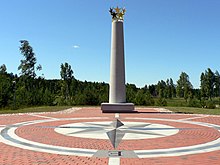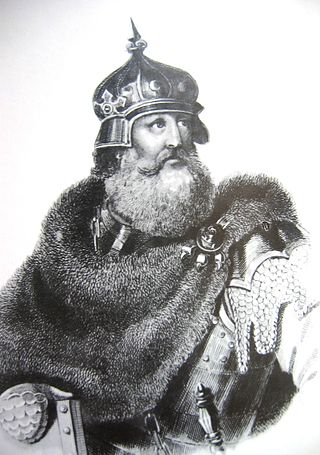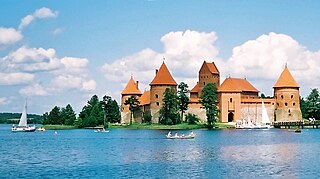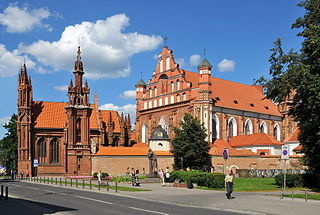




Trakai is a city and lake resort in Lithuania. It lies 28 kilometres west of Vilnius, the capital of Lithuania or just 7 kilometres from the administrative limits of the Lithuanian capital city. Because of its proximity to Vilnius, Trakai is a popular tourist destination. Trakai is the administrative centre of Trakai district municipality. The city is inhabited by 5,357 people, according to 2007 estimates. A notable feature of Trakai is that the city was built and preserved by people of different nationalities. Historically, communities of Karaims, Tatars, Lithuanians, Russians, Jews and Poles lived here.

Vytautas, also known as Vytautas the Great from the late 14th century onwards, was a ruler of the Grand Duchy of Lithuania. He was also the prince of Grodno (1370–1382), prince of Lutsk (1387–1389), and the postulated king of the Hussites.

The Karaim language, also known by its Hebrew name Lashon Kedar is a Turkic language belonging to the Kipchak group, with Hebrew influences, similarly to Yiddish or Judaeo-Spanish. It is spoken by only a few dozen Crimean Karaites in Lithuania, Poland, Crimea, and Galicia in Ukraine. The three main dialects are those of Crimea, Trakai-Vilnius and Lutsk-Halych, all of which are critically endangered. The Lithuanian dialect of Karaim is spoken mainly in the town of Trakai by a small community living there since the 14th century.

Kęstutis was the Grand Duke of Lithuania. He was the Duke of Trakai and governed the Grand Duchy of Lithuania, 1342–1382, together with his brother Algirdas, and with his nephew Jogaila.

The Columns of Gediminas or Pillars of Gediminas are one of the earliest symbols of Lithuania and its historical coats of arms. They were used in the Grand Duchy of Lithuania, initially as a rulers' personal insignia, a state symbol, and later as a part of heraldic signs of leading aristocracy.

Trakai Voivodeship, Trakai Palatinate, or Troki Voivodeship, was a unit of administrative division and local government in the Grand Duchy of Lithuania from 1413 until 1795.

Trakai District Municipality is one of 60 municipalities in Lithuania.

Trakai Historical National Park is a national park in Lithuania. It was designated in 1992 to embrace the historic city of Trakai, some 25 kilometers west of Vilnius, and the forests, lakes, and villages in its environs. The Park has Category II in the classification of the IUCN. It is the only historical national park in Europe.

Trakai Peninsula Castle is one of the castles in Trakai, Lithuania. It is located on a peninsula between southern Lake Galvė and Lake Luka. Built around 1350–1377 by Kęstutis, Duke of Trakai, it was an important defensive structure protecting Trakai and Vilnius, capital of the Grand Duchy of Lithuania, against attacks of the Teutonic Knights. Much of the castle was destroyed in the 17th century. Remaining walls and towers are preserved and protected by the Trakai Historical National Park.

Trakai Island Castle is an island castle located in Trakai, Lithuania, on an island in Lake Galvė. The construction of the stone castle was begun in the 14th century by Kęstutis, and around 1409 major works were completed by his son Vytautas the Great, who died in this castle in 1430. Trakai was one of the main centers of the Grand Duchy of Lithuania and the castle held great strategic importance. The castle was rebuilt in the 1950s–1960s by Lithuanian initiative, although it had received resistance from Soviet authorities. The Trakai History Museum was established after the reconstruction.

Senieji Trakai Castle was a castle in Senieji Trakai, Lithuania.

Lake Galvė is a lake in Trakai, Lithuania. It has 21 islands, and one of them houses Trakai Island Castle. Trakai Peninsula Castle is located on its southern shore. There are ruins of the little Orthodox church in Bažnytėlė Island. Trakai was the capital of the Grand Duchy of Lithuania from 1321 to 1323 before moving to Vilnius. The lake and most of the other lakes surrounding the castle and city have myths and legends connected to them, of which most contain a tragic love story.

Lithuania attracts many visitors from neighbouring countries and from all over the world. In 2018,there were 1.7 million foreign visitors to Lithuania for business, family and leisure. The historical legacy of the Grand Duchy of Lithuania, its rich history, architecture, pristine nature, seaside and spa resorts are the main attraction points of Lithuania. Domestic tourism is also highly popular: in 2018 it grew by 12%. Lithuanians also prefer to spend their vacations in Lithuania – 70 percent.

Senieji Trakai is a historic Lithuanian village located 3 kilometres (1.9 mi) east of Trakai. According to the Lithuanian census of 2011, it has 1,396 inhabitants – Lithuanians, Poles and Russians. The Saint Petersburg–Warsaw Railway passes through Senieji Trakai.

The Duchy of Lithuania was a state-territorial formation of ethnic Lithuanians that existed from the 13th century to 1413. For most of its existence, it was a constituent part and a nucleus of the Grand Duchy of Lithuania. Other alternative names of the territorial formation, used in different periods, were Aukštaitija or Land of Lithuania, Duchy of Vilnius, Lithuania proper, or simply Lithuania.

Marcjan Aleksander Ogiński was a Polish-Lithuanian nobleman, a military commander and a statesman of the Grand Duchy of Lithuania in the Polish–Lithuanian Commonwealth. He advanced to colonel (pulkownik) in 1657, served as Voivod of Trakai and Grand Chancellor of Lithuania. He was the signatory of the Eternal Peace Treaty of 1686 with the Tsardom of Russia, on the side of the Grand Duchy of Lithuania.

The Lithuanian Civil War of 1381–1384 was the first struggle for power between the cousins Jogaila, Grand Duke of Lithuania and later King of Poland, and Vytautas the Great. It began after Jogaila signed the Treaty of Dovydiškės with the Teutonic Knights which was aimed against his uncle Kęstutis, father of Vytautas. Kęstutis briefly seized power in the Grand Duchy, but was betrayed by adherents of Jogaila primarily from Vilnius. During negotiations for a truce Kęstutis and Vytautas were arrested and transported to the Kreva Castle. Kęstutis died there a week later but Vytautas managed to escape and then sought an alliance with the Teutonic Knights. Subsequently their joint forces raided Lithuanian lands. Eventually the cousins were reconciled as Jogaila needed internal stability in anticipation of negotiations with the Grand Duchy of Moscow and the Kingdom of Poland regarding the possible Christianization of Lithuania. The war did not settle the power struggle; it continued during the next Lithuanian Civil War (1389–1392) which was resolved by the signing of the Ostrów Agreement. After more than ten years of struggle, Vytautas finally became the Grand Duke of Lithuania and ruled the country for thirty-eight years.
Duchy of Trakai was a subdivision of the Grand Duchy of Lithuania during the 14th and early 15th centuries. The Duke of Trakai was an important position held either by the Grand Duke of Lithuania himself or his second-in-command.

Lithuania is not the very centre of Gothic architecture, but it provides a number of examples, partly very different and some quite unique.

Užutrakis Manor is a late 19th-century residential manor of the Tyszkiewicz family in Užutrakis, on the shore of Lake Galvė, opposite the famous Trakai Castle.